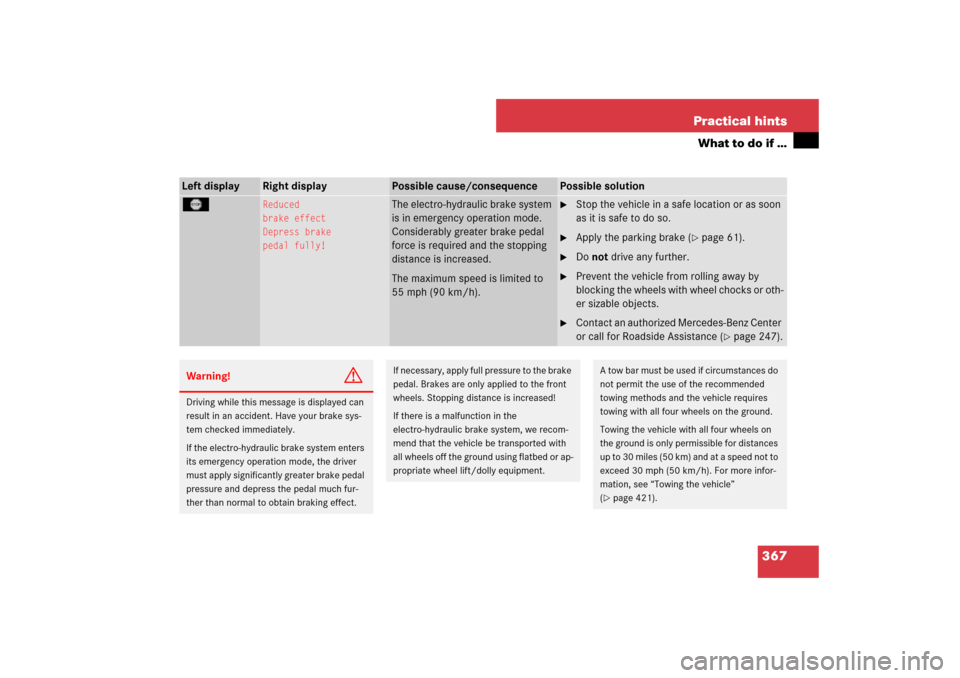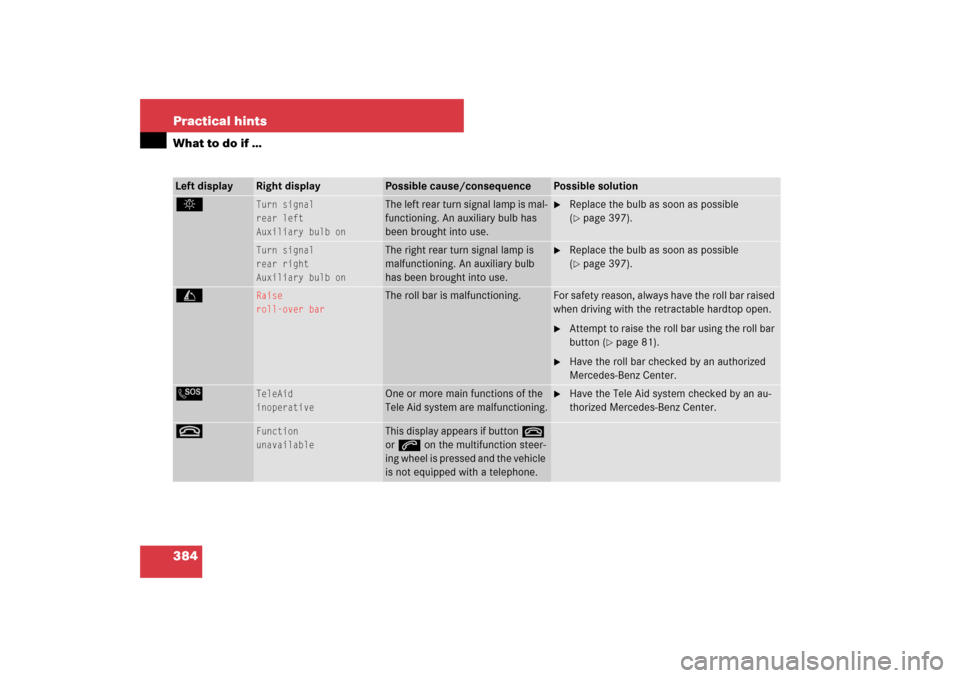Page 363 of 473

362 Practical hintsWhat to do if …Left display
Right display
Possible cause/consequence
Possible solution
Check tires
Then restart
Run Flat Indicator
There was a warning message
about a loss in the tire inflation
pressure and the Run Flat Indica-
tor has not been reactivated yet.
�
Make sure that the correct tire inflation
pressure is set for each tire.
�
Then reactivate the Run Flat Indicator.
Run Flat Indicator
inoperative
The Run Flat Indicator is
malfunctioning.
�
Have the Run Flat Indicator checked by an
authorized Mercedes-Benz Center.
The Run Flat Indicator has been
switched off due to an error.
Tire pressure
Check tires
The Run Flat Indicator indicates
that the pressure is too low in one
or more tires.
�
Carefully bring the vehicle to a halt, avoiding
abrupt steering and braking maneuvers. Ob-
serve the traffic situation around you.
�
Check and adjust tire inflation pressure as
required (
�page 292).
�
If necessary, change the wheel
(�page 405).
�
Reactivate the Run Flat Indicator after ad-
justing the tire inflation pressure values
(�page 294).
Page 364 of 473

363 Practical hints
What to do if …
Left display
Right display
Possible cause/consequence
Possible solution
Tire pressure
displayed after
driving for
a few minutes
Vehicles with Advanced TPMS*:
The tire inflation pressure is being
checked.
�
Drive the vehicle for a few minutes.
Tire pressure monitor
inoperative
The TPMS or Advanced TPMS* is
malfunctioning.
�
Have the TPMS or Advanced TPMS*
checked by an authorized
Mercedes-Benz Center.
Tire pressure monitor
inoperative
No wheel sensors
There are wheels without appropriate
wheel sensors mounted (e.g. winter
tires).
�
Have the TPMS or Advanced TPMS*
checked by an authorized
Mercedes-Benz Center.
�
Have appropriate wheel sensors in-
stalled by an authorized Mercedes-Benz
Center.
Tire pressure monitor
Wheel sensor missing
One or more sensors defect (e.g. emp-
ty sensor battery).
One or more wheels without appropri-
ate wheel sensors mounted (e.g. spare
wheel).
�
Have the TPMS or Advanced TPMS*
checked by an authorized
Mercedes-Benz Center.
�
Have appropriate wheel sensors in-
stalled by an authorized Mercedes-Benz
Center.
Vehicles with Advanced TPMS*:
The tire pressure for the respective tire
is indicated in the multifunction display.
Page 365 of 473
364 Practical hintsWhat to do if …Left display
Right display
Possible cause/consequence
Possible solution
Tire pressure monitor
currently
unavailable
The TPMS or Advanced TPMS* is
unable to monitor the tire pres-
sure due to�
a nearby radio interference
source.
�
excessive wheel sensor tem-
peratures.
As soon as the causes for the malfunction are
no longer present, the TPMS or Advanced
TPMS* automatically becomes active again
after a few minutes driving.
Warning!
G
Do not drive with a flat tire. A flat tire affects
the ability to steer or brake the vehicle.
You may lose control of the vehicle. Contin-
ued driving with a flat tire will cause exces-
sive heat build-up and possibly a fire.
Page 368 of 473

367 Practical hints
What to do if …
Left display
Right display
Possible cause/consequence
Possible solution
T
Reduced
brake effect
Depress brake
pedal fully!
The electro-hydraulic brake system
is in emergency operation mode.
Considerably greater brake pedal
force is required and the stopping
distance is increased.
The maximum speed is limited to
55 mph (90 km/h).
�
Stop the vehicle in a safe location or as soon
as it is safe to do so.
�
Apply the parking brake (
�page 61).
�
Do not drive any further.
�
Prevent the vehicle from rolling away by
blocking the wheels with wheel chocks or oth-
er sizable objects.
�
Contact an authorized Mercedes-Benz Center
or call for Roadside Assistance (
�page 247).
Warning!
G
Driving while this message is displayed can
result in an accident. Have your brake sys-
tem checked immediately.
If the electro-hydraulic brake system enters
its emergency operation mode, the driver
must apply significantly greater brake pedal
pressure and depress the pedal much fur-
ther than normal to obtain braking effect.
If necessary, apply full pressure to the brake
pedal. Brakes are only applied to the front
wheels. Stopping distance is increased!
If there is a malfunction in the
electro-hydraulic brake system, we recom-
mend that the vehicle be transported with
all wheels off the ground using flatbed or ap-
propriate wheel lift/dolly equipment.
A tow bar must be used if circumstances do
not permit the use of the recommended
towing methods and the vehicle requires
towing with all four wheels on the ground.
Towing the vehicle with all four wheels on
the ground is only permissible for distances
up to 30 miles (50 km) and at a speed not to
exceed 30 mph (50 km/h). For more infor-
mation, see “Towing the vehicle”
(�page 421).
Page 369 of 473

368 Practical hintsWhat to do if …Left display
Right display
Possible cause/consequence
Possible solution
USA only:;Canada only:3
Reduced
brake effect
Visit
workshop
The electro-hydraulic brake system
is in emergency operation mode.
Considerably greater brake pedal
force is required and the stopping
distance is increased.
�
Stop the vehicle in a safe location or as soon
as it is safe to do so.
�
Apply the parking brake (
�page 61).
�
Do not drive any further.
�
Prevent the vehicle from rolling away by
blocking the wheels with wheel chocks or oth-
er sizable objects.
�
Contact an authorized Mercedes-Benz Center
or call for Roadside Assistance (
�page 247).
Warning!
G
Driving while this message is displayed can
result in an accident. Have your brake sys-
tem checked immediately.
If the electro-hydraulic brake system enters
its emergency operation mode, the driver
must apply significantly greater brake pedal
pressure and depress the pedal much fur-
ther than normal to obtain braking effect.
If necessary, apply full pressure to the brake
pedal. Brakes are only applied to the front
wheels. Stopping distance is increased!
If there is a malfunction in the
electro-hydraulic brake system, we recom-
mend that the vehicle be transported with
all wheels off the ground using flatbed or ap-
propriate wheel lift/dolly equipment.
A tow bar must be used if circumstances do
not permit the use of the recommended
towing methods and the vehicle requires
towing with all four wheels on the ground.
Towing the vehicle with all four wheels on
the ground is only permissible for distances
up to 30 miles (50 km) and at a speed not to
exceed 30 mph (50 km/h). For more infor-
mation, see “Towing the vehicle”
(�page 421).
Page 376 of 473

375 Practical hints
What to do if …
Left display
Right display
Possible cause/consequence
Possible solution
_
Entry position
Do not drive
The steering wheel has not yet
moved into its stored driving posi-
tion.
�
Wait until the steering wheel has moved to its
driving position.
The message disappears.
N
USA only:Add 1 qt. engine oil
at next refuelingCanada only:Add 1 liter
engine oil
at next refueling
Vehicles with engine oil measuring
system only:
The engine oil level is too low.
�
Add engine oil (
�page 278) and check the
engine oil level (�page 276).
Engine oil level
Stop car –
turn engine off
Vehicles with engine oil measuring
system only:
There is no oil in the engine. There
is a danger of engine damage.
�
Stop the vehicle in a safe location or as soon
as it is safe to do so.
�
Turn off the engine.
�
Add engine oil (
�page 278) and check the
engine oil level (�page 276).
Engine oil level
Reduce
oil level
Vehicles with engine oil measuring
system only:
You have added too much engine
oil. There is a risk of damaging the
engine or the catalytic converter.
�
Have excess oil siphoned or drained off. Ob-
serve all legal requirements with respect to its
disposal.
Page 385 of 473

384 Practical hintsWhat to do if …Left display
Right display
Possible cause/consequence
Possible solution
.
Turn signal
rear left
Auxiliary bulb on
The left rear turn signal lamp is mal-
functioning. An auxiliary bulb has
been brought into use.
�
Replace the bulb as soon as possible
(�page 397).
Turn signal
rear right
Auxiliary bulb on
The right rear turn signal lamp is
malfunctioning. An auxiliary bulb
has been brought into use.
�
Replace the bulb as soon as possible
(�page 397).
C
Raise
roll-over bar
The roll bar is malfunctioning.
For safety reason, always have the roll bar raised
when driving with the retractable hardtop open.�
Attempt to raise the roll bar using the roll bar
button (
�page 81).
�
Have the roll bar checked by an authorized
Mercedes-Benz Center.
L
TeleAid
inoperative
One or more main functions of the
Tele Aid system are malfunctioning.
�
Have the Tele Aid system checked by an au-
thorized Mercedes-Benz Center.
t
Function
unavailable
This display appears if button t
or s on the multifunction steer-
ing wheel is pressed and the vehicle
is not equipped with a telephone.
Page 386 of 473

385 Practical hints
What to do if …
Left display
Right display
Possible cause/consequence
Possible solution
H
Please correct
the tire pressure
The tire inflation pressure is too
low in one or more tires.
�
Check and correct tire inflation pressure as required
(�page 292).
Tire pressure
Caution
Tire defect
One or more tires are deflating.
�
Carefully bring the vehicle to a halt, avoiding abrupt
steering and braking maneuvers.
�
If necessary, change the wheel (
�page 405).
Caution
Tire defect
Vehicles with Advanced TPMS*:
One or more tires are deflating.
The respective tire is indicated in
the multifunction display.
�
Carefully bring the vehicle to a halt, avoiding abrupt
steering and braking maneuvers.
�
If necessary, change the wheel (
�page 405).
Warning!
G
Do not drive with a flat tire. A flat tire affects
the ability to steer or brake the vehicle.
You may lose control of the vehicle. Contin-
ued driving with a flat tire will cause exces-
sive heat build-up and possibly a fire.